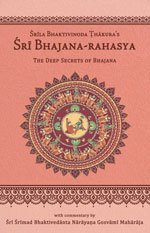Bhajana-Rahasya
by Srila Bhaktivinoda Thakura Mahasaya | 2010 | 123,965 words
The Bhajana-rahasya Text 29, English translation, including commentary (vritti). The Bhajana-rahasya is a compilation of verses describing the mercy of the eight pairs of names (Yugala-nama) of the Maha-mantra. This is text 29 belonging to the chapter “Prathama-yama-sadhana (Nishanta-bhajana–shraddha)” representing the last six dandas of the night: approximately 3.30 a.m.–6.00 a.m.
Text 29
The Vedas (Ṛg Veda, also Śrīmad-Bhāgavatam 12.6.39) states:
ततो’भूत् त्रिवृद् ओंकारो यो’व्यक्त प्रभवः स्वराट्
यत् तल् लिङ्गं भगवतो ब्रह्मणः परमात्मनःtato’bhūt trivṛd oṃkāro yo’vyakta prabhavaḥ svarāṭ
yat tal liṅgaṃ bhagavato brahmaṇaḥ paramātmanaḥŚrī Bhagavān is imperceptible; He is both undivided and divided. The transcendental vibration oṃ is His manifestation, and He is manifest in the three forms of brahma, Paramātmā and Bhagavān. The three syllables in the oṃkāra represent the names Hari, Kṛṣṇa and Rāma. The name of Hari is non-different from Hari Himself.
अव्यक्त हैते कृष्ण स्वराट् स्वतन्त्र
ब्रह्म, आत्मा, भगवान् लिङ्ग-त्रय तन्त्रavyakta haite kṛṣṇa svarāṭ svatantra
brahma, ātmā, bhagavān liṅga-traya tantraअ-कार उ-कार आर म-कार निर्देश
ओं हरि कृष्ण राम नामेर विशेषa-kāra u-kāra āra ma-kāra nirdeśa
oṃ hari kṛṣṇa rāma nāmera viśeṣaहरि हैते अभिन्न सकल हरिनाम
वाच्य-वाचक-भेदे पूर्ण करे कामhari haite abhinna sakala harināma
vācya-vācaka-bhede pūrṇa kare kāma
Commentary: Bhajana-rahasya-vṛtti:
The manifest brahma, Śrī Kṛṣṇa, is much greater than the unmanifest brahma and completely independent from it. Parabrahma Śrī Kṛṣṇa is always manifest in the three forms of brahma, Paramātmā and Bhagavān. The three sounds in the oṃkāra–a, u and m–represent Hari, Kṛṣṇa and Rāma, respectively. Śrī Hari is non-different from all the names of Hari. His personal form is known as vācya (that which is nameable) and His transcendental name is known as vācaka (that which denotes). These two forms fulfil the desires of each and every sādhaka. (The syllables in the oṃkāra also have the following meaning: a–Kṛṣṇa, u–Śrī Rādhā, m–gopīs, and the candrabindu [the dot over the m]–the living entity.)
